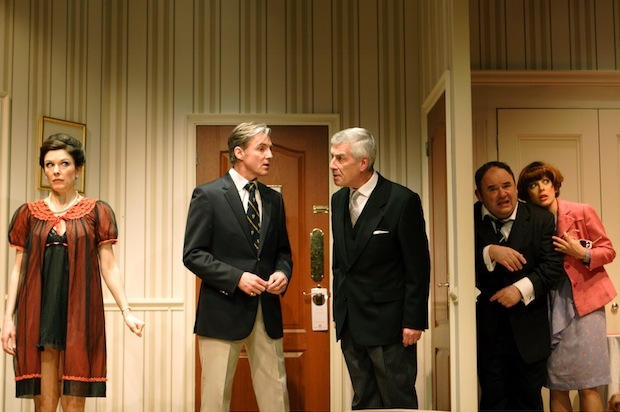Ray Cooney, the master of farce, is back. These days he’s in the modest Menier rather than the wonderful West End. His 1984 caper, Two Into One, opens with Richard, a starchy Tory minister, plotting an affair with a sexy blonde researcher, Jennifer. Richard decides to attempt a daring double bluff by booking Jennifer into a hotel in Westminster where his gullible wife Pamela is already installed for the weekend. Pamela meanwhile starts an indiscretion with Richard’s bungling junior, George, but their dalliance is compromised when Jennifer’s husband Ted turns up and is mistaken for George’s ‘boyfriend’, whom George has invented to conceal his affair with Pamela. Improbable? You bet. But the play’s effervescent silliness banishes one’s disbelief to the sidelines.
The cast are good to watch and Cooney, who directs his own script, plays a cameo role as a hapless old waiter who likes practising kung fu and keeps hoofing spare guests in the knackers. He even takes a spill on stage and lands in a heap of sprawling body parts. And he’s 81 years old. There are a couple of ‘buts’ about this show. Josefina Gabrielle, as Pamela, is far too beautiful and stylish to be a credible rejectee. Richard’s wife should be a horsey frump, pushing 60, and sheathed head to foot in prickly tweeds. His decision to risk his career by swapping his lovely spouse for a younger replica who only just surpasses her in desirability seems perverse. And a simmering little bundle of provocation like Pamela wouldn’t fall for a waddling misfit like George. Not in a million years. My guess is that Cooney’s eye for the ladies got the better of him in the audition room and he cast Gabrielle when he really needed a goofy, flat-chested shrew.
The other ‘but’ is the unevenness of Cooney’s talent. His gift for farcical choreography is world-class but he has no interest in psychological portraiture. Every character is defined by their immediate predicament and by their fear of discovery and humiliation. Of course, complaining that the personalities in a slapstick comedy are too shallow is like telling Chef that his Waldorf salad is short of Ribena but it mars the overall experience. The play ends abruptly, and with nothing resolved, when Richard steps forward and declares the whole charade finished. That’s it. Lights up. Curtain call. Home you go. It’s like eating a pound of cheesy Wotsits for supper. The hunger is quelled but the palate isn’t gratified, never mind the spirit.
The Print Room welcomes a play by Norwegian writing sensation Jon Fosse. His scripts are performed all over the world and he wins prizes and honours on every continent. Such is his prestige in Norway that the royal family has granted him a suite of rooms at the palace. The Dead Dogs is a family nightmare set in a crimson cabin overlooking a fog-bound fjord. A mute young lad refuses to talk to his jabbering mother. A school-friend pops in and departs. His sister and brother-in-law follow suit.
The real action takes place off-stage and it involves a lot of killing. First a dog is killed. Then the dog’s killer is identified and killed. Finally the killer of the dog’s killer is identified and there the play ends. These events take 100 minutes to grind through and the characters stand about discussing the blood-letting and its consequences in disjointed passages of innocuous chatter.
The word ‘Yes’ is repeated incessantly. A character will enter and say ‘Yes’ a couple of times and the other characters will respond with meandering yes-crammed replies of their own. The purpose of this yes mountain is to convey inarticulacy, complacency, aggression, fear of interaction and perhaps other latent and uncomfortable social vices too. It’s an original idea, if a little threadbare, but Fosse pounds at it so hard that it becomes mannered and artless.
The psychology of the family is as blank as the action. The characters, all unnamed, have no insight, wit or imagination, and not the slightest trace of inner landscaping. It’s like spending a long awkward night with five pilled-up depressives on the brink of a suicide pact. ‘Dear God,’ I found myself praying, ‘please put yourselves out of my misery.’ Fosse has never found success over here and he blames our theatrical tradition and Britain’s ‘fear of what is different’. In fact Beckett and N.F. Simpson were delivering this kind of stilted, artificial absurdism to the London stage 50 years ago. They added jokes as well. What Fosse calls ‘different’ we would call samey, dated and sterile. At least his play helps to explain why London’s theatre is the most popular in Europe. They’re all fleeing Fosse and his posse of pretentious Pinter-gazumping bores.







Comments